Underground Water Line Installation Cost Per Foot
Your main water line is crucial to your home’s plumbing system, delivering fresh water from the city’s supply directly to your home. This vital component is located underground, out of sight, and can last up to 50 years if installed correctly. However, if it starts to fail, you might notice issues like reduced water pressure or an unexpectedly high water bill. Several factors influence the cost of installing a new water line, including the distance the line must cover, the diameter of the pipe, and the material used. With rising material costs and an ongoing shortage of plumbers, the cost of “behind the wall” plumbing projects is expected to continue increasing through 2024 and beyond.
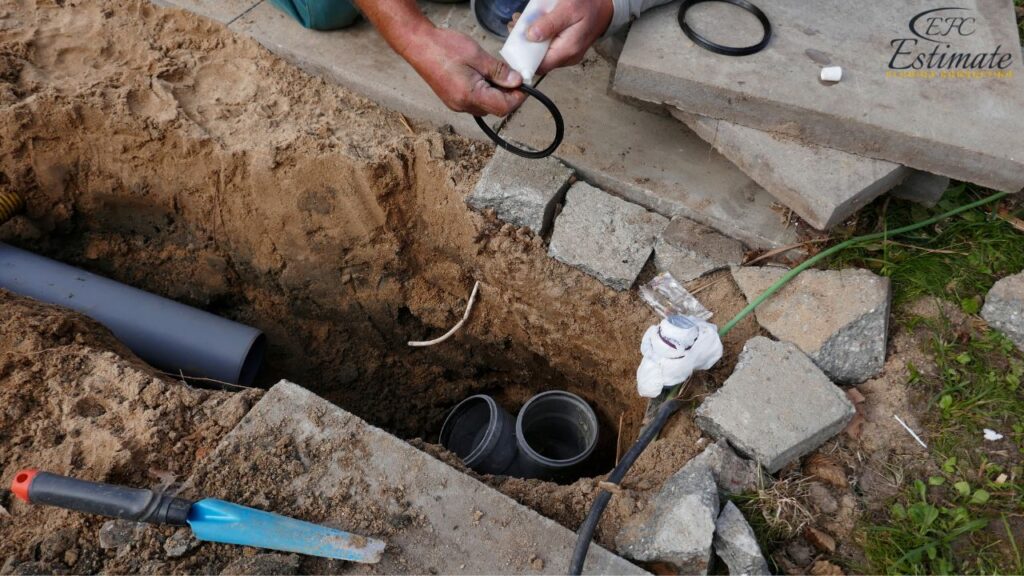
For main line installations, you can anticipate a cost increase of 5.2% to 11%. On a national level, the cost to replace a main water line typically ranges from $1,950 to $15,600, with most homeowners spending around $4,875 to replace a 25-foot long main line using galvanized steel with a trenchless installation method. On the lower end, you might pay about $1,462.50 to replace a 10-foot long main line with PVC pipe using a trenchless method. For more extensive projects, such as replacing a 100-foot long main line with copper pipe using traditional trench digging, costs can reach up to $29,250.
Cost to Install Main Water Line
Water Main Installation Cost | Cost |
National Average Cost | $4,875 |
Average Range | $1,950 – $15,600 |
Low-end | $1,462.50 |
High-end | $29,250 |
Main Water Line Installation Cost per Foot
The main water line is an essential connection between your home and your town or city’s main water supply. It runs underground from the edge of your property to the water meter at your house, typically passing through your yard. Whether this line runs through your front, side, or backyard doesn’t affect the cost—what matters is the length of the line, the type of pipe used, and the connections required.
In most cases, your main water line connects to your home’s plumbing system, which can be above ground or in the basement, depending on your home’s layout. If your home has a basement where most of the plumbing is located, the connection will likely be made there. The costs for this are generally the same unless you decide to change the location of the line, such as moving it to the basement, which may require drilling a new hole through your foundation and slightly increase the cost.
Since the distance the line needs to cover varies from property to property, the cost of installation is usually calculated per linear foot. Several factors, including the installation method, pipe material, and soil conditions, can impact the cost per foot. With rising material costs, you can expect the cost to install your main water line to range from $97.50 to $292.50 per foot, with most homeowners paying between $130 and $260 per linear foot. The farther your home is from the road, the higher the overall cost of the project.
Length | Cost (Installed) |
10 Feet | $975 – $2,925 |
25 Feet | $2,437.50 – $7,312.50 |
50 Feet | $4,875 – $14,625 |
75 Feet | $7,312.50 – $21,937.50 |
100 Feet | $9,750 – $29,250 |
Main Water Line Replacement Cost by Method
When it comes to replacing your main water line, the majority of the cost comes from the labor involved in the installation. While the material you choose does affect the final price, the installation method plays a much bigger role. There are two main methods for installing or replacing a main water line that runs from the street to your home.
The first method is digging and backfilling. This involves digging a trench in your yard to access, lay, or remove the pipes. The second, more modern method is trenchless installation. This technique only requires two small holes—one near the street and one near your meter.
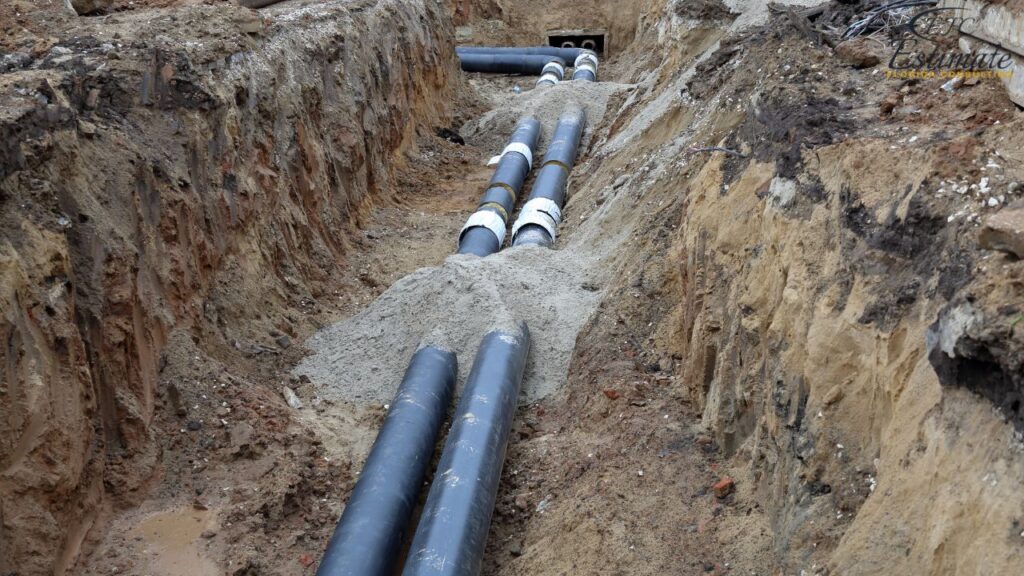
The pipe is then threaded through the ground between these two points. Trenchless installation is generally less expensive, causes less disruption to your property, and is the most commonly used method unless specific issues prevent its use. Below are the updated costs for these two installation methods.
Installation Type | Cost per Linear Foot (Labor Included) |
Trenchless | $97.50 – $195 |
Digging and Backfilling | $227.50 – $292.50 |
Trenchless Water Main Replacement
Trenchless water main replacement is a popular and efficient method for installing or replacing your main water line. On average, the cost ranges from $97.50 to $195 per linear foot. This technique involves drilling two small holes—one near the street and one near your meter—and then threading the new pipe through a tunnel created between these two points. Trenchless installation is preferred whenever possible because it minimizes disruption to your landscaping and is generally quicker and less invasive. With this method, you avoid the significant upheaval of your yard, making it the go-to option for many homeowners.
Digging and Backfilling a Trench
If trenchless installation isn’t feasible, the alternative method involves digging and backfilling a trench. This process typically costs between $227.50 and $292.50 per linear foot. These costs are primarily for the excavation and do not include additional expenses like replanting grass, repairing sidewalks, or restoring other affected areas. In this method, an excavator digs a large trench across your property to expose the old water line. The line is then manually removed and replaced with a new one, and the trench is filled back in. This approach is more common for new installations or situations where the main valve is located under a sidewalk or another hard-to-reach area that requires extensive digging.
Cost of a New Main Water Line by Material
When installing a new main water line, the material you choose plays a significant role in the overall cost, as well as the durability and suitability for your specific location. While cost is certainly important, you also need to consider factors like city regulations, climate, and soil type. Some cities have strict guidelines on the type and size of the pipe you can use, while others give you more flexibility based on your water needs and the conditions of your property.
For most single-family homes, the main water line typically ranges from ¾” to 2” in diameter, with 1” being the most common choice.
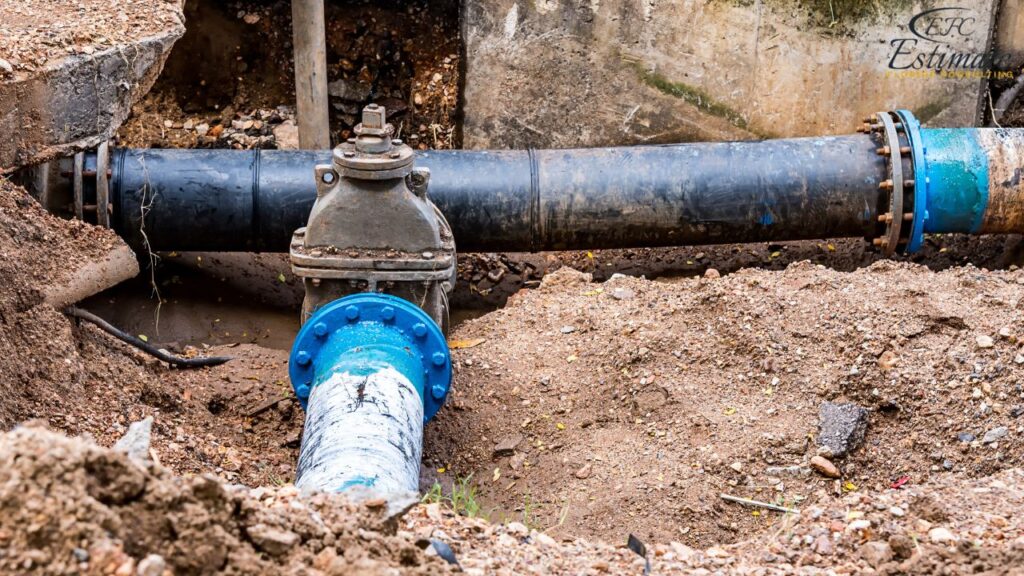
The diameter is usually determined by the distance from the water supply and the elevation of your home. A narrower diameter can increase water pressure, especially if your home is situated above the main supply. However, a 1” diameter is generally recommended for most situations. Your plumber will help you determine the best option for your project.
There are several materials commonly used for water lines, each with its own advantages and drawbacks. These include PVC, polyethylene, cast iron, fiberglass, brass, and copper. PVC is the least expensive option and is not affected by soil type, but it is unsuitable for hot climates and must be buried deep in cold climates. Polyethylene is versatile and resistant to both heat and cold, making it a good alternative, though it can be more challenging to install. Cast iron is durable and resistant to temperature extremes and soil conditions, but it is prone to corrosion and is less commonly used today. Brass and copper are premium materials that offer excellent durability but can corrode in high-pH soil, making them more suitable for specific environments. Fiberglass is strong and ideal for short runs, though it’s best used for homes located less than 10 feet from the road due to its limited length availability.
Below are the updated average costs for different materials, reflecting the recent cost increases.
Material | Cost per Linear Foot |
PVC | $26 – $39 |
Polyethylene | $39 – $65 |
Cast Iron | $65 – $104 |
Fiberglass | $78 – $104 |
Brass | $104 – $156 |
Copper | $117 – $195 |
Labor Cost for a Plumber to Replace a Main Water Line
Replacing or installing a main water line involves similar labor costs, with the work typically costing between $91 and $260 per hour, depending on the complexity of the job. Plumbers generally charge within this range for both new installations and replacements, making the overall labor costs quite comparable between the two.
While there are slight differences between a new installation and a replacement, the time and effort required are usually very similar. For a new installation, the plumber will need to lay the pipe and install a new water meter and valve at your home. In a replacement, the existing water meter and valve often remain in place, but the old pipe must be removed before the new one is installed. This process can take just as much time, leading to comparable costs. However, certain challenges, like removing an old pipe tangled with tree roots, can increase labor costs. If a new water meter is needed, this could also raise the cost. Overall, both types of projects tend to fall within the same price range.
Cost of Moving a Main Water Pipe
Moving a main water pipe can be a more complex and costly project, with costs ranging from $130 to $325 per linear foot. The old pipe must be disconnected and removed. If the existing pipe is in good condition, it may be reused, but often a new pipe is installed. The process is similar to installing a new line, but with the added step of relocating the connection, which may require digging up sidewalks or other structures. This added complexity can lead to higher labor costs than a standard installation or replacement. Additionally, after the pipe is moved, you’ll be responsible for any necessary repairs to the sidewalk or other areas affected by the excavation.
Cost to Replace a Main Water Shut-Off Valve
Replacing the main water shut-off valve typically costs between $260 and $1,300. The shut-off valve is located where the water enters your home and is essential for quickly turning off the water supply in case of an emergency. The cost of replacing this valve varies based on factors such as the valve’s age, accessibility, and the materials used in the valve and connecting pipes. You generally don’t need to replace the valve when installing a new water line unless the new pipe material is incompatible with the existing valve. For example, if you’re switching from a cast iron pipe to a PVC pipe, you may need a new valve that fits the updated materials. Additionally, if you upgrade to a larger pipe size, you’ll need to replace the valve accordingly, which can increase the overall cost of the project.
Signs You Need a New Water Main
There are several warning signs that your water main may need to be repaired or replaced. One of the first signs is an unexpected increase in your water bill without any corresponding increase in usage. This could indicate a leak in the main line. Another clue is if you notice that the grass over the area where your water main is located appears unusually green and lush. This is often a result of water leaking from the pipe and nourishing the surrounding soil.
As the problem worsens, you might experience a noticeable drop in water pressure, which occurs because more water is escaping from the leak than is reaching your home’s plumbing system. In more severe cases, you may see your lawn or landscaping becoming overly saturated with water. This can lead to puddles or even water-filled depressions in your yard, indicating that the pipe has failed completely and needs immediate attention.
90% More Chances to Win Projects With Our Estimate!
- Multi-Family Building
- Hotel Building
- Hospital Building
- Warehouse Building
- School & University Building
- High-Rise Building
- Shopping Complex
- Data Center Building
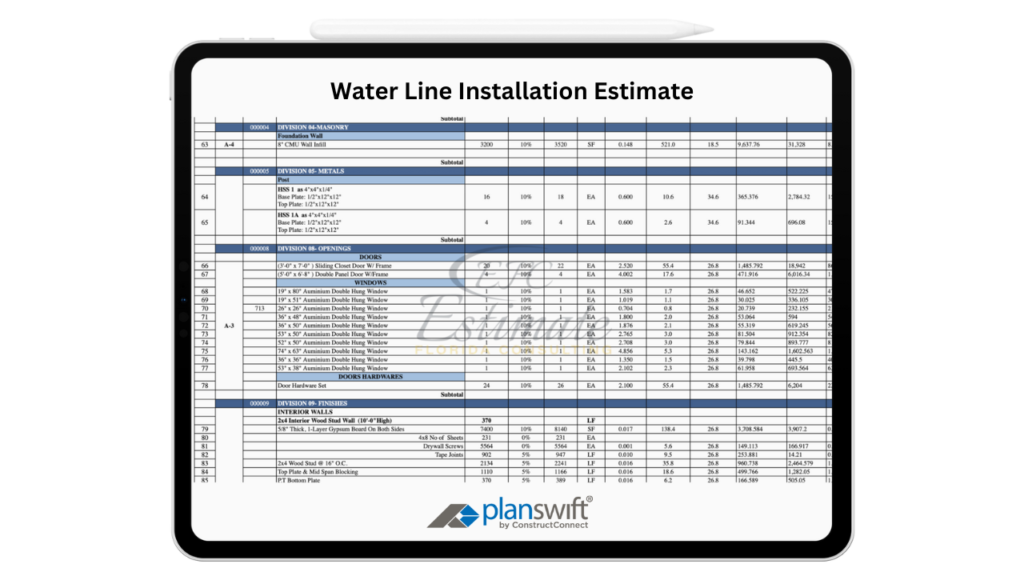
Enhancement and Improvement Costs
Cleanup
After your new water line is installed, there might be some mud or dirt inside the line. To prevent this debris from circulating through your home’s plumbing, the line can be professionally flushed for $65 to $130. While this step might not always be necessary, it can save you the hassle of having to clean mud or dirt from your sinks, tubs, and other fixtures later. Although you could flush the line yourself by running water through various taps in your home, having it done professionally is quicker and more thorough.
New Water Pressure Regulator
A water pressure regulator ensures that the water pressure throughout your home remains consistent. Sometimes, it may need to be replaced when your main water line is repaired or replaced. If you’ve noticed inconsistent water pressure, where one part of your home has better pressure than another, installing a new regulator can help. It’s often more cost-effective to add a regulator during the water line installation or replacement. However, in some cases, replacing the water line itself might resolve pressure issues, so it’s a good idea to consult with your plumber. The cost of installing a new pressure regulator ranges from $325 to $520.
Tap Replacement
The tap is the connection point between your home’s water line and the city’s main water supply. If your water line is very old, it’s advisable to replace the tap when you replace the line, especially if both are made from materials like cast iron that may be corroding. Replacing the tap along with the line ensures compatibility and reduces the risk of future problems. The cost for replacing the tap typically ranges from $390 to $650.
Additional Considerations and Costs
Depth
Your main water line is typically buried at least 1 foot beneath the ground, but depending on factors like soil type, climate, and the depth of the municipal supply line, it may need to be buried 2 or even 3 feet deep. While this usually doesn’t affect costs much with trenchless installation, it can significantly increase expenses if a trench needs to be dug, as the deeper you go, the more labor and time are required.
Permits
Before installing a new water main, you’ll need to obtain the necessary permits and get approval from your city. These permits add to your overall project cost and can range from $65 to $520 for a plumbing permit. Be sure to consult with your plumber to understand which permits you’ll need for your specific project.
Roots
Tree and shrub roots can sometimes invade your water main line, drawn by the moisture, and cause the pipe to burst. If this happens, you may need to remove nearby trees or bushes when replacing the line. This additional work can increase the overall cost of your project.
Repair vs. Replacement
In some cases, your water main line can be repaired rather than completely replaced. Repairs typically cost between $650 and $2,600, which can be a more cost-effective option, especially for long water lines. Repairing the line may save you both time and money, depending on the extent of the damage.
Access
The cost of replacing your water main line can increase if the pipe is difficult to access. Obstacles like trees, large stones, or complex landscaping can make the job more challenging and time-consuming, leading to higher labor costs.
Insurance Coverage
Standard home insurance policies typically don’t cover the main water line. To ensure coverage, you’ll need to add “service line coverage” to your policy.
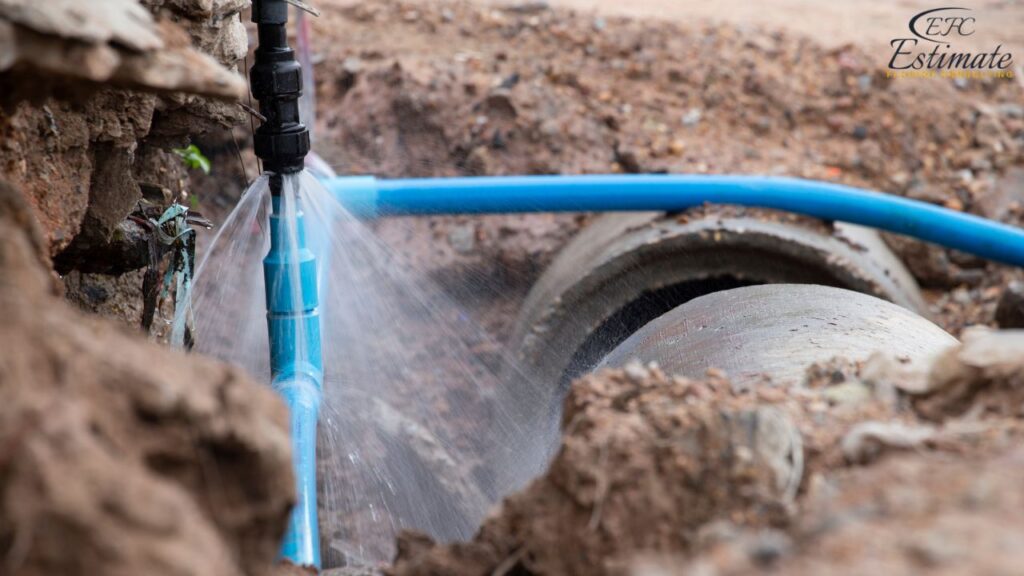
This type of coverage can protect you in case of repairs or replacements needed for your main water line, as well as your sewer and septic lines. It’s a good idea to speak with your insurance adjuster to learn more about adding this coverage to your policy.
What is mains water connection?
Any public water works supply system has pipework designed to distribute water to homes and businesses. These large pipes are often referred to as water mains, while the water supplied is known as mains water.
Main Water Line Replacement Cost Factors
When it comes to replacing your main water line, several factors can significantly impact the overall cost. Understanding these factors and how they contribute to the expense can help you plan and budget effectively. Let’s break down the key considerations:
Length & Depth of the Water Line
The length and depth of your water line are crucial factors that determine the total cost. The longer the water line, the more materials and labor are needed, which increases the price. Additionally, in colder climates, water lines are buried deeper to protect them from freezing. This added depth can make trenching more labor-intensive, driving up costs further. If your home is set back far from the street, expect these costs to be on the higher end.
Accessibility Challenges
How accessible your water line is plays a big role in determining replacement costs. If the line is buried under thick landscaping, driveways, sidewalks, or rocky soil, the job becomes more complex and time-consuming, leading to higher labor charges. Obstacles like these make it harder for plumbers to reach and replace the line, adding to the overall expense.
Impact of Vegetation on Water Line Replacement
Vegetation can be both a friend and foe when it comes to your water main. While trees and shrubs enhance the beauty of your yard, their roots can cause serious damage to underground water lines. If intrusive roots have damaged your pipe, you may need to remove these plants to prevent future issues.
Tree removal costs can range from $195 to $2,600 depending on the tree’s size, while removing bushes or shrubs might cost between $32.50 and $195 each.
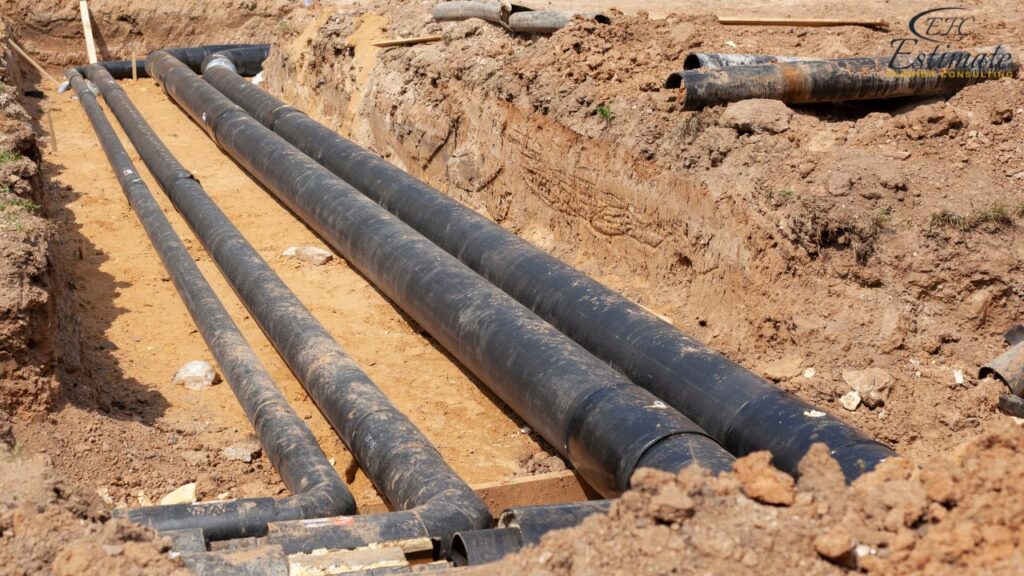
Pipe Diameter and Material Choices
The diameter of the pipe used for your water line affects both the material cost and the overall price of the project. Larger pipes require more material, which naturally increases costs. Most residential water service lines are between ¾ inch and 1 inch in diameter. Choosing the right diameter is important for maintaining proper water pressure, and larger diameters can be more expensive but may be necessary depending on your home’s needs.
Deciding Between Repair and Full Replacement
Sometimes, repairing a damaged water line is a viable option and can be significantly less expensive than a full replacement. Repair costs typically range from $520 to $1,950. If only a small section of the line is damaged and the rest is in good shape, a repair might be all you need. However, if the pipe is old or severely corroded, replacing the entire line is often the better choice, even though it will cost more.
Trenchless vs. Trenching Replacement Methods
The method used to replace your water line—trenchless or trenching—can have a big impact on the cost. Trenchless water line replacement is less invasive and generally more expensive upfront, but it can save money in the long run by avoiding extensive landscape or driveway repairs. Trenching, on the other hand, involves digging up the yard, which can add costs for excavation and subsequent repairs. While trenching may seem cheaper initially, the additional repair costs can add up quickly.
Costs of Moving the Water Line Location
If you need to move the location of your main water line, expect additional costs. Relocating the line requires more excavation and repair work, which adds to the overall expense. This can be necessary if the current location is difficult to access or prone to problems, but it’s important to factor in the extra costs when planning your budget.
Replacing the Main Water Shut-Off Valve
The main water shut-off valve is a critical component of your plumbing system, allowing you to control the water flow into your home. Replacing this valve typically costs between $325 and $780. You might need a new valve if the pipe size changes or if the new pipe material is incompatible with the existing valve. Ensuring that the shut-off valve is in good working order is essential for preventing leaks and water damage.
Download Template For Water Line Installation Project Breakdown
- Materials list updated to the zip code
- Fast delivery
- Data base of general contractors and sub-contractors
- Local estimators
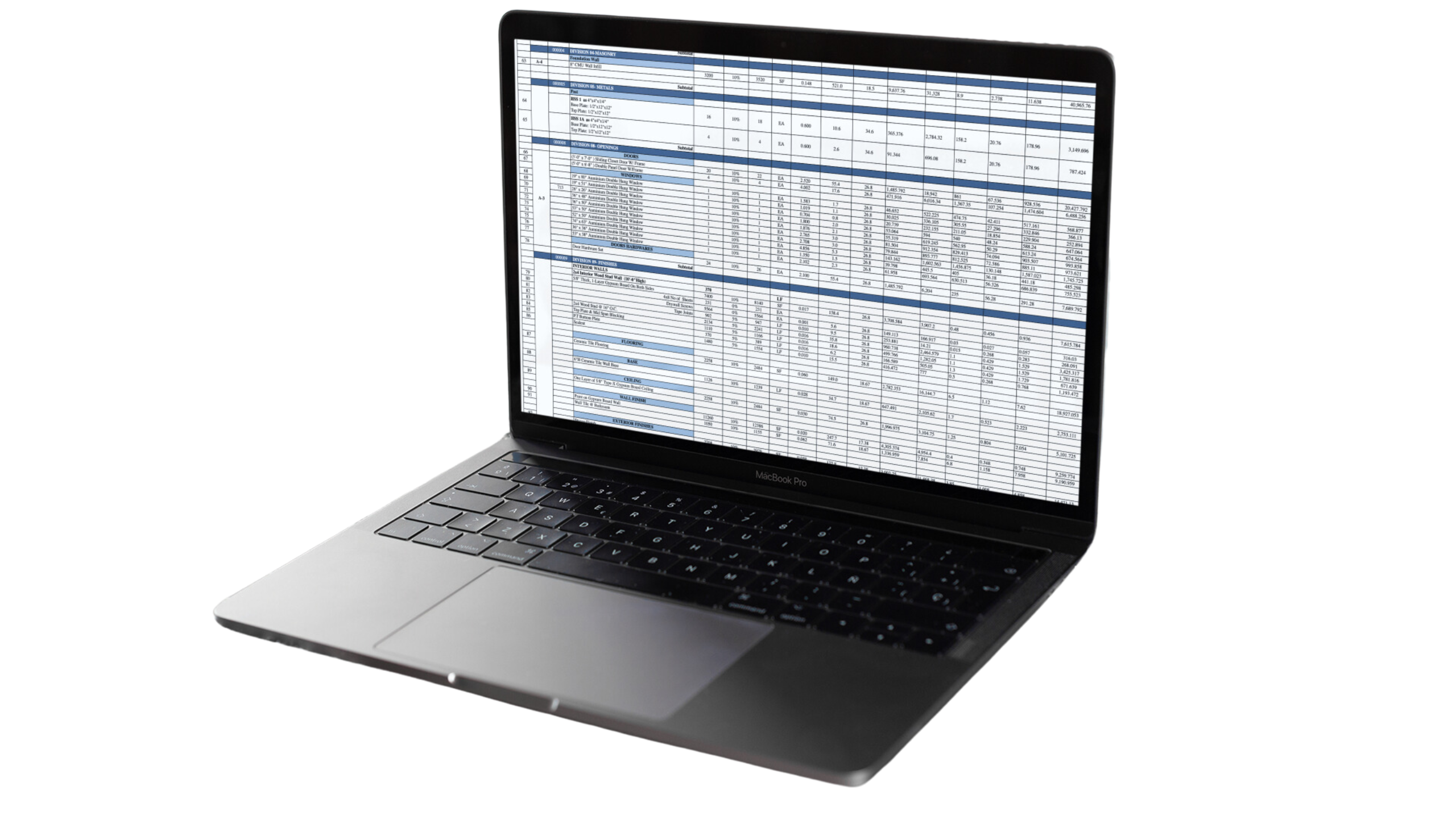
Installing or Replacing a Water Pressure Regulator
A water pressure regulator helps maintain consistent water pressure throughout your home. If you’re experiencing uneven water pressure—like strong flow in one bathroom and weak flow in another—it might be time to replace the regulator. The cost for installing a new pressure regulator ranges from $195 to $455. This could be a worthwhile investment during a main water line replacement to ensure your plumbing system operates smoothly.
Tap Connection Replacement Costs
The tap connection is the valve that links your home’s water line to the city’s main line. If your water line is old or if you’re upgrading to a new pipe material, replacing the tap connection may be necessary to ensure compatibility. This typically costs between $390 and $650, including parts and labor. Replacing the tap connection can help prevent future leaks and ensure a secure connection to the city’s water supply.
Labor Costs for Main Water Line Replacement
Labor is one of the most significant expenses when it comes to replacing your main water line. Plumbing professionals typically charge between $58.50 and $195 per hour, and the time required for the job can vary greatly depending on the complexity of the project. Some replacements might only take a few hours, while others could span several days, especially if there are complications.
Here’s a breakdown of other labor-related costs you might encounter:
- Plumbing Inspection: Before any work begins, a plumber will need to inspect your system to locate the problem and determine whether the water line needs repair or replacement. This inspection typically costs between $130 and $260 or more, depending on the extent of the issue.
- Plumbing Permits: You’ll also need to obtain permits for the water line replacement. The cost of these permits can range from $39 to $650, depending on your location and the scope of the work.
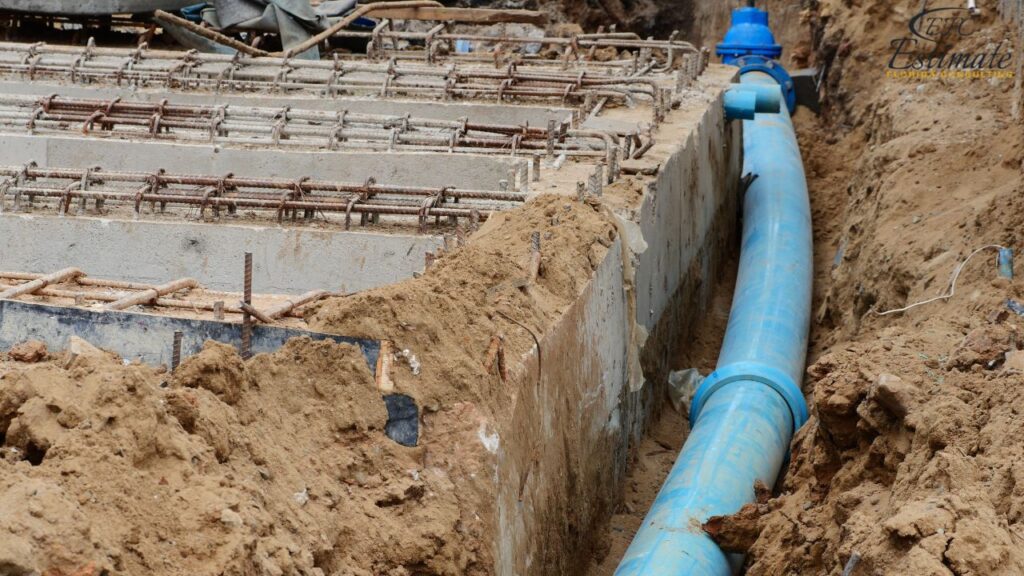
- Installing New Plumbing Pipes: If your home’s plumbing is old, it might be a good idea to replace the existing pipes along with the water line. Re-piping an entire house can cost anywhere from $2,964 to $6,656 in total. This is especially important if your pipes are more than 50 years old, as they may be prone to leaks or other issues.
Pipe Material Costs
Water line pipes typically cost between $0.65 to $13.00+ per linear foot before installation, depending on the material. The best pipe material for your water line will depend on your local climate, soil conditions, and specific needs. Your plumbing professional will guide you in selecting the most suitable material for your situation, ensuring durability and efficiency for years to come.
Pipe Material | Average Price per Linear Foot | Details |
PVC | $0.65 – $6.50 | Easy to install; no special equipment required. Low maintenance, long lifespan. Works well in acidic soil. Not recommended for extreme temperatures. May sustain damage from tree roots or chemicals. |
PEX / Polyethylene | $0.65 – $6.50 | More flexible and easier to install than PVC. Resists corrosion; less likely to crack in freezing temps. Lasts up to 50 years. Not as strong as copper or steel. Does not repair as easily as PVC. |
Copper | $2.60 – $13.00+ | Holds up well in freezing temperatures. Lasts up to 100 years. Expensive. May corrode and leak over time. Not recommended for hard water areas. |
Cast Iron | $2.60 – $13.00 | Found mostly in older homes. Prone to corrosion. Easily damaged by roots. |
Fiberglass | $7.80 – $16.90 | Sold in short lengths. Very durable. Resists weather and soil damage. |
Conclusion
Installing or replacing your main water line is a crucial task that ensures the steady delivery of fresh water to your home. This underground line, often out of sight and out of mind, can last up to 50 years when properly installed. However, when it begins to fail, you may notice issues like a sudden spike in your water bill or a drop in water pressure. With rising material costs and a shortage of plumbers, the cost of such projects is expected to increase by 5.2% to 11% through 2024. The national average for replacing a main water line ranges from $1,950 to $15,600, with most homeowners spending around $4,875. The cost per linear foot can vary from $97.50 to $292.50, depending on factors like the length of the line, the material used, and the method of installation. Whether you opt for trenchless installation or the traditional digging method, it’s essential to consider all factors that might affect the cost, from labor and permits to potential landscaping repairs. Planning ahead and understanding these costs will help you manage your budget and avoid unexpected expenses, ensuring your home’s plumbing system remains reliable and efficient for years to come.
FAQs
Several factors affect the cost of installing a new main water line, including the distance the line must cover, the diameter and material of the pipe, and the method of installation. Rising material costs and a shortage of plumbers are also contributing to higher prices, with expected cost increases of 5.2% to 11% through 2024.
On a national level, replacing a main water line typically costs between $1,950 and $15,600. Most homeowners spend around $4,875 to replace a 25-foot main line using galvanized steel with a trenchless installation method. The cost can be as low as $1,462.50 for a 10-foot line made of PVC, and as high as $29,250 for a 100-foot line made of copper with traditional trench digging.
The cost to install a main water line varies based on the method of installation and the material used. Typically, it ranges from $97.50 to $292.50 per foot. Factors like the length of the line, soil conditions, and the type of pipe used can all influence the final price.
The cost of installing a water line is generally the same whether it runs through your front, side, or backyard. The key factors affecting cost are the length of the line, the type of pipe used, and the complexity of the installation.
There are two primary methods for replacing a main water line: trenchless installation and digging with backfilling. Trenchless installation, which involves threading the pipe through the ground with minimal disruption, costs between $97.50 and $195 per linear foot. Digging and backfilling, which involves excavating a trench to lay or remove pipes, costs between $227.50 and $292.50 per linear foot.
Trenchless water main replacement is less invasive and typically faster, with costs ranging from $97.50 to $195 per foot. This method is preferred whenever possible because it minimizes disruption to your landscaping and is generally quicker and less invasive. However, it may not be suitable in all situations, such as when there are significant obstacles like tree roots or utility lines.
If trenchless installation isn’t feasible, the alternative is digging and backfilling a trench, which costs between $227.50 and $292.50 per foot. This method is more labor-intensive and can lead to additional costs for repairing landscaping, sidewalks, or driveways that are disrupted during the excavation.
The material used for the water line significantly impacts the overall cost. PVC pipes are the least expensive, costing between $26 and $39 per foot, while premium materials like copper can cost between $117 and $195 per foot. Other options include polyethylene, cast iron, fiberglass, and brass, each with its own price range and suitability depending on your location and soil conditions.
Labor costs for replacing or installing a main water line typically range from $91 to $260 per hour, depending on the complexity of the job. The total labor cost can vary depending on the length of the line, the installation method, and any challenges such as tree roots or difficult access.
Moving a main water pipe is more complex and costly, with prices ranging from $130 to $325 per foot. This process involves disconnecting and removing the old pipe, possibly installing a new pipe, and relocating the connection, which may require additional excavation and repairs.
Replacing the main water shut-off valve costs between $260 and $1,300. This valve is crucial for controlling the water supply to your home and may need to be replaced if the pipe material or size is changed during the water line replacement.
Signs that your water main may need replacement include an unexpected increase in your water bill, unusually green grass over the water line, reduced water pressure, and waterlogged areas in your yard. If you notice any of these issues, it’s important to have your water line inspected by a professional.
Additional costs can include cleanup (flushing the new line), installing a new water pressure regulator, and replacing the tap connection to the city’s main line. You may also need to factor in the cost of removing tree roots or bushes if they’ve damaged the water line, as well as the cost of obtaining permits and addressing any accessibility challenges.
Google Reviews



Process To Get Underground Water Line Installation Estimate Report
Here I am going to share some steps to get underground water line installation estimate report.
-
You need to send your plan to us.
You can send us your plan on info@estimatorflorida.com
-
You receive a quote for your project.
Before starting your project, we send you a quote for your service. That quote will have detailed information about your project. Here you will get information about the size, difficulty, complexity and bid date when determining pricing.
-
Get Estimate Report
Our team will takeoff and estimate your project. When we deliver you’ll receive a PDF and an Excel file of your estimate. We can also offer construction lead generation services for the jobs you’d like to pursue further.

